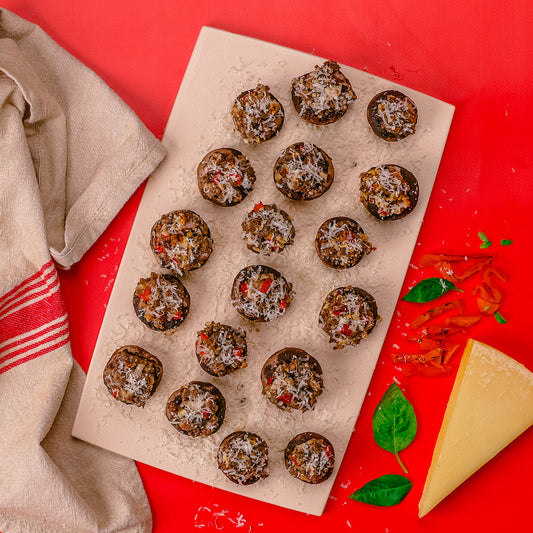
How to Cook Chuck Roast
Cooking a Chuck Roast can be a daunting task becuase it's a larger cut of beef. When you learn to cook it the right way it will turn into a staple in any kitchen. We love ingredients that can be thrown in a slow cooker or made into freezer meals for later (like this Mexican Pot Roast). It saves us time and allows us to spend more time eating, which, let's be real, is the best part of most days. We've pinpointed the most important 5 habits to break when cooking Chuck Roast. After this, cooking a large cut of beef will be as easy as tying your shoes.
1. Only letting your Chuck roast cook for 3 hours. Give it time.
Chuck roast needs time to break down when cooking to avoid becoming tough.
Can you guess where chuck roast comes from? If you said the shoulder of the animal– you'd get a gold star. Let's break this down, beef geek style, and talk about the science behind this muscle. It gets a huge workout from moving the front legs and the head up and down when grazing.
The toughness of meat all comes down to connective tissue. Exercise increases the amount of connective tissue, therefore muscles that the animal uses more will have more connective tissue. Because of this, a chuck roast will have more collagen, which is a connective tissue that helps hold the meat’s muscle fibers together. When cooked with moisture (see our tip below on braising!), collagen breaks down into gelatin which helps the fibers separate. This gives you that “fall-apart” texture in stews and roasts.
Collagen takes time to break down, so cooking a chuck roast for longer periods of time at lower temperatures is crucial. Think “low and slow” to give you that tender texture of the beef falling apart and melting in your mouth.
2. You don't sear your Chuck Roast on the stove before putting it in your slow cooker.
Don’t miss out on flavor! .This process is called "searing." When you sear at high heat, you build a delicious flavor by kickstarting a chemical reaction called the Maillard reaction.
The Maillard reaction is an interaction between amino acids and reducing sugars that occurs at high temperatures and browns the surface of food. This gives the chuck roast a nuanced and toasted flavor.
This reaction is essential to cooking beef, not only because it imparts color and creates that perfect “crust”, but because it creates hundreds of different flavor compounds that give off an array of aromas and tastes.
Without searing, beef can taste flavorless and one-dimensional. Even toasted bread, chocolate and beer owe their flavor complexity to this reaction!
3. You trim off ALL the fat from the Chuck before cooking.
You commonly hear that fat = flavor. Although our leanest cuts of grass fed and finished beef still tastes amazing. Fatt does lend a hand to our delicious chuck roast.
If you are making a stew and cut up the chuck roast into large chunks. It is totally fine to remove the bigger portions of fat if you wish, but please, for your sake, keep the nice, intramuscular fat. It will break down when cooking and lend to an incredible flavor, and a really nice sauce at the end!

4. You cook without any liquid or braising.
Braising is a moist cooking method where tough cuts of meat are cooked in partial liquid at low temperatures for long periods of time.
When cooked in the presence of moisture, the connective tissue in the beef breaks down, which allows the meat fibers to separate more easily. This is fundamental in tenderizing tough cuts of meat.
The goal is to break down the collagen in the connective tissue into gelatin, a protein that will thicken the braising liquid to create a rich, velvety sauce. Tender meat with a flavorful sauce is a perfect combination.
Don’t forget our favorite phrase when cooking chuck roast - “low and slow”. Keep your braising liquid at a simmer at all times. The higher the cooking temperature, the tougher the muscle fibers become, so avoid keeping your liquid at a boil.
5. You put your Chuck Roast in the slow cooker without salt.
Salt is a magical ingredient. The addition of a good quality salt, like our favorite Real Salt, enhances flavor exponentially. There are 5 basic tastes that exist – sour, sweet, salt, bitter, and umami. When you increase or add one of these, you bring out or enhance another.
When adding salt to savory products like meat, you enhance the umami taste which creates that satisfying, “I need to have another bite” sensation. A little salt can even enhance the taste of sweet, which is why you add a pinch of salt to cookies and oatmeal.
Remember to salt each side of your chuck roast prior to searing and braising to really bring out those delicious, beefy flavors. As a tip, try sprinkling the salt from higher up above the meat, it will help to coat the surface more evenly.

Adding Pre Chuck Roast to your meal plan is a great way to add protein and healthy fats to your diet. It is also a great addition if you are doing Whole30® this January! Make sure to check out Pre's Guide to Whole30 where you can find recipes, including the Italian Beef recipe above, and tips and tricks on how to complete a successful Whole30®.


